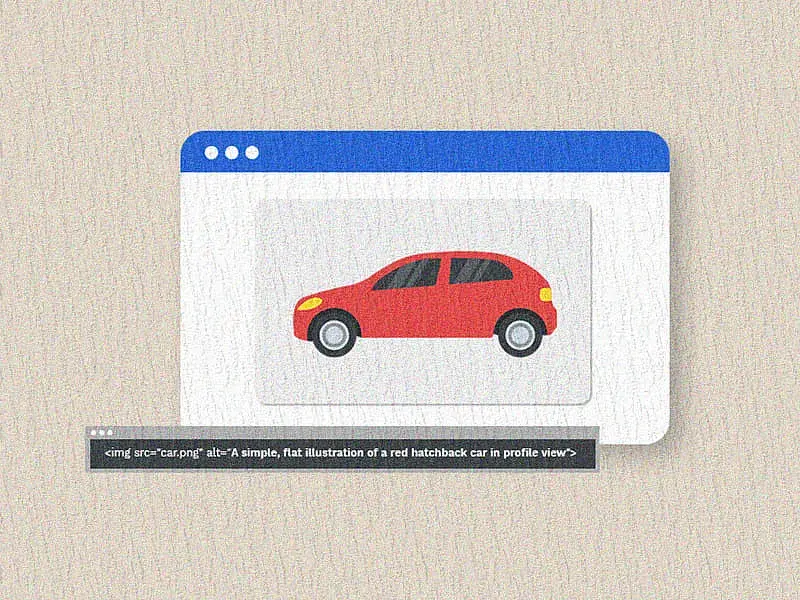Table of contents
- 1. No compromises with Semantic HTML
- 2. Keyboard navigation is a must!
- 3. Color contrast adjustment can go a long way
- 4. Small details, big value - Alt text and media descriptions
- 5. Accessible forms and error-handling messages
- 6. Testing with real users - manual & automated
- 7. Accessibility needs to be maintained with regular audits
- Final thoughts
Accessibility isn’t just a checkbox to tick off your list of requirements. It’s a smart move that can help your business grow in many ways.
More than just a nice-to-have feature to avoid legal trouble, accessibility is a must-have. An inaccessible website can easily cost you your brand’s credibility and the audience’s trust.
When you make your website accessible to all, you’re not only attracting a wider audience, you’re improving brand credibility too. Users with visual or mobility impairments, or those using assistive technologies, can easily access your content. That’s inclusivity in action, and a smart move for business growth.
In this blog, we will talk about how Drupal can be a powerful tool in making your website more accessible. Starting from semantically rich code to optimized user experiences and content workflows, we’ll discuss seven practical tips to boost your website’s accessibility. No fluff, only impact!
1. No compromises with Semantic HTML
Would you build your house with a broken foundation? Of course not. The same logic applies to your website code. Semantic HTML is the way to go for a proper content structure that adds value to your website. It makes it easier for screen readers and other assistive tools to properly interpret your web pages.
Tags like <header>, <main>, <article>, and <nav> are the prompts that simplify it for users to understand your content. Proper implementation of headings (from <h1> to <h6>) improves navigation and SEO.
How can Drupal help?
Drupal has a content architecture that leverages semantic markup by default. When done right, it can deliver clean, structured HTML directly out of the box. The HTML5 initiative took a big step forward towards a more semantic and accessibility-friendly experience.
2. Keyboard navigation is a must!
Most users rely on keyboards, by need or by preference. You must make your website keyboard-friendly so that you don’t miss out on the majority of the crowd. You can implement logical tab order on your web pages, help guide your users with the help of visible focus indicators, and bypass repetitive navigation using skip links.
How can Drupal help?
Thanks to Drupal’s range of themes and modules like Editoria11y, Accessibility Toolkit, and Civic Accessibility toolbar, which helps you streamline keyboard navigation. If you ask us, our accessibility services are designed to implement such features into your experience from day one.
Additionally, Olivero and Claro are two of Drupal’s default themes that adhere to WCAG 2.1 AA guidelines and are designed with accessibility in mind. Besides navigability, these themes help simplify color contrast adjustment and typography readability.
3. Color contrast adjustment can go a long way
Color contrast combos may look great on your designer’s screen. But if it compromises the website’s readability, users with low vision will struggle to navigate your site. This is a UX fail on your part. It’s essential to adjust the color contrast between the text and the background. Legibility is greater than aesthetics here.
Proper color contrast helps users with color blindness, aging eyes, and even mobile users trying to read your content under bright light. Besides, let's not forget about the WCAG 2.1 compliance - it isn’t optional!
How can Drupal help?
At Specbee, we make the most of Drupal’s capabilities. One of our approaches is to conduct a thorough design audit with the help of tools like WebAIM’s Contrast Checker and Deque's axe DevTools. We also closely collaborate with the branding team to ensure accessibility doesn’t affect your website’s visual identity.
4. Small details, big value - Alt text and media descriptions
Alt text isn’t just an old SEO gimmick. It’s essential for users who are unable to see your images. When you have your alt text written thoughtfully, it describes the content and its visual functions for users to understand the context effectively.
Make sure to describe all your complex images, like charts and infographics, in detail. Don’t forget to use captions and transcripts for your audio and video content.
How can Drupal help?
Drupal’s power, when implemented, can simplify the workflows starting from the CMS interface. We can help you achieve such goals with our content teams that curate good alt text habits for projects.
For example, with the help of Drupal core’s Media Library, you can reuse media assets while curating consistent metadata like alt text, titles, and descriptions. Additionally, contributed modules like Automatic Alternative Text, Image Widget Crop, and Focal point can help with AI-generated alt text, precise image framing, and context, respectively.
5. Accessible forms and error-handling messages
If you thought filling out forms was frustrating, imagine filling them up when they’re broken! It’s almost impossible for screen readers or tab keys to crack those broken forms. You have to make sure to have accessible forms with clear labels linked to inputs. While you’re at it, also ensure to enable descriptive error messages for a clearer idea about the issue. Implement logical tab order and focus states for these accessible forms.
How can Drupal help?
Drupal’s very popular Webform module gives you a solid head start. If you aren’t sure how to make the most of it, we can help. Our approach is very straightforward – we layer the module features with usability best practices and tailored error messaging by studying real user behavior.
6. Testing with real users - manual & automated
Sure, tools and AI are here to simplify things. However, they’re simplifying things for human users. So, it makes a lot of sense to test your end products on real humans. Automated audits, such as WAVE or axe can’t replicate the perspective of real human users. Blending such tools with manual testing can give you a solid idea about the product.
You can implement automated tools for quick diagnostics. Use tools like NVDA and VoiceOver for screen reader testing. Additionally, user feedback loops are helpful during QA cycles.
How can Drupal help?
Besides tools like WAVE or axe, Drupal offers contributed modules like Editoria11y Accessibility Checker for content authors and editors to add a real-time a11y checker in the admin UI. Additionally, Drupal’s Accessibility Scanner integrates axe-core testing for scanning your web pages to locate and fix any accessibility errors.
7. Accessibility needs to be maintained with regular audits
Accessibility isn’t a ‘done and dusted’ task. It is an ongoing process. Just like you keep a regular check on your site’s security and performance, accessibility needs regular check-ins as well. A solid accessibility maintenance plan should include quarterly accessibility audits, timely content updates, and adjustments based on the latest WCAG standards.
Strong accessibility measures keep your site compliant, user-friendly, and future-proof - and that’s exactly what we promise our clients with our accessibility services.
Final thoughts
When it comes to accessibility, you need to be more critical than just ticking off compliance boxes. Being a part of the digitally evolved landscape, it is important to align with the recent trends and requirements. That said, from boosting SEO to expanding your market base, accessibility should be a strategic business move and not an afterthought. Accessibility is one of the smartest business investments you can make. And we’re here to help you do it right and do it well.
Talk to us - we start with a free consultation followed by a full accessibility audit. And then our experts take it from wherever you are!







